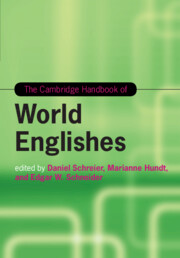Book contents
- The Cambridge Handbook of World Englishes
- Cambridge Handbooks in Language and Linguistics
- The Cambridge Handbook of World Englishes
- Copyright page
- Dedication
- Contents
- Figures
- Maps
- Tables
- Notes on Contributors
- 1 World Englishes: An Introduction
- Part I The Making of Englishes
- Part II World Englishes Old and New
- 7 A Sociolinguistic Ecology of Colonial Britain
- 8 English in North America
- 9 English in the Caribbean and the Central American Rim
- 10 English in Africa
- 11 English in South Asia
- 12 English in Southeast Asia
- 13 World Englishes Old and New: English in Australasia and the South Pacific
- Part III Linguistics and World Englishes
- Part IV Current Challenges
- Index
- References
12 - English in Southeast Asia
from Part II - World Englishes Old and New
Published online by Cambridge University Press: 16 December 2019
- The Cambridge Handbook of World Englishes
- Cambridge Handbooks in Language and Linguistics
- The Cambridge Handbook of World Englishes
- Copyright page
- Dedication
- Contents
- Figures
- Maps
- Tables
- Notes on Contributors
- 1 World Englishes: An Introduction
- Part I The Making of Englishes
- Part II World Englishes Old and New
- 7 A Sociolinguistic Ecology of Colonial Britain
- 8 English in North America
- 9 English in the Caribbean and the Central American Rim
- 10 English in Africa
- 11 English in South Asia
- 12 English in Southeast Asia
- 13 World Englishes Old and New: English in Australasia and the South Pacific
- Part III Linguistics and World Englishes
- Part IV Current Challenges
- Index
- References
Summary
While the historical emergence and present-day settings of English in Southeast Asia are highly varied, it is possible, nevertheless, to identify a number of key themes that can provide important insights into the changing status and properties of English in this region. In this regard, the chapter begins by selectively focusing on the history of English in Singapore, Malaysia, the Philippines, and Thailand, in order to highlight how (post)colonization influences the ways in which English inserts itself into different countries. The chapter then draws attention to issues that are fundamental to understanding the contemporary development of English, such as neoliberalism, migration, and commodification. Retaining the earlier connection with the focus on (post)colonization, the chapter closes by considering possible strategies of decolonization as different Southeast Asian countries attempt to evolve beyond the constraints of exonormativity and linguistic insecurity.
Keywords
- Type
- Chapter
- Information
- The Cambridge Handbook of World Englishes , pp. 263 - 281Publisher: Cambridge University PressPrint publication year: 2020
References
- 2
- Cited by



